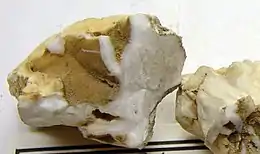Bakerite
Bakerite is the common name given to hydrated calcium boro-silicate hydroxide, a borosilicate mineral (chemical formula Ca4B4(BO4)(SiO4)3(OH)3·(H2O)) that occurs in volcanic rocks in the Baker, California area.[1] Discredited mineral: IMA2016-A.
| Bakerite | |
|---|---|
 Bakerite sample | |
| General | |
| Category | Nesosilicate |
| Formula (repeating unit) | Ca4B4(BO4)(SiO4)3(OH)3·H2O |
| Strunz classification | 9.AJ.20 |
| Crystal system | Monoclinic |
| Crystal class | Prismatic (2/m) (same H-M symbol) |
| Space group | P21/c |
| Unit cell | a = 4.85 Å, b = 7.627 Å, c = 9.659 Å; β = 90.255°; Z = 1 |
| Identification | |
| Color | Colorless, white |
| Mohs scale hardness | 4 1⁄2 |
| Luster | Vitreous, dull |
| Diaphaneity | Translucent |
| Specific gravity | 2.88 |
| Optical properties | Biaxial (-) |
| Refractive index | nα = 1.624 nβ = 1.635 nγ = 1.654 |
| Birefringence | δ = 0.030 |
| 2V angle | Measured: 87° to 88° |
It was first described in 1903 for an occurrence in the Corkscrew Canyon Mine of the Black Mountains, Furnace Creek District, Death Valley National Park, Inyo County, California, US.[2] It was named for Richard C. Baker, a director of the Pacific Coast Borax Company.[3][4]
References
- "Bakerite mineral data". WebMineral.com. Archived from the original on 5 April 2009. Retrieved 2009-05-08.
- Mindat.org
- Handbook of Mineralogy
- Hildebrand, GH. (1982) Borax Pioneer: Francis Marion Smith. San Diego: Howell-North Books. p. 89. (ISBN 0-8310-7148-6)
This article is issued from Wikipedia. The text is licensed under Creative Commons - Attribution - Sharealike. Additional terms may apply for the media files.